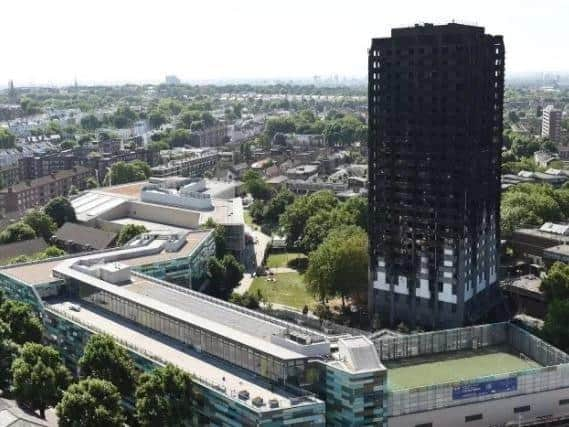The Sheffield tower block residents still trapped inside dangerous buildings - four years on from Grenfell disaster


In the early hours of June 14, 2017, a fire broke out in the kitchen of a fourth floor flat on Grenfell Tower, in North Kensington, West London, and within minutes it raced up the exterior of the building and spread to all four sides, engulfing the 24 storey tower block in a blaze and killing 72 people.
Four years on, a public inquiry into the disaster is still ongoing, new safety issues with buildings are still being found and millions of people across the country are facing enormous bills to fix a crisis they did not cause.
Advertisement
Hide AdAdvertisement
Hide AdOlivia Hill, PhD student at Sheffield University and a leaseholder in a city centre Sheffield tower block, was devastated when issues came to light about her building only last October.
She said: “The first thing I did was buy a fire extinguisher and a blanket.
“It’s completely unbelievable that it’s taken this long, I’ve bought my flat since Grenfell and it was allowed to be sold, unsafe. Nothing would have been picked up if it hadn’t been for this year with the external wall surveys. It’s just unbelievable that it’s still allowed to happen.”
The survey on her block cost around £16,000, charged to the leaseholders and the estimated cost of fixing issues - including with cladding, balconies, fire breakers and fire alarm - is around £4 million.
Advertisement
Hide AdAdvertisement
Hide AdThey are hoping some of that will be covered by a long-awaited government fund but in the meantime it hangs over their heads. If the full figure was charged to leaseholders, Ms Hill said she would have to pay around £40,000 - half the cost of the flat she saved up to buy.
“It’s a really horrible situation to be in, not knowing what to do for the best - whether to hang on and wait for funding or pay out in the meantime for other things,” she said.
“It’s huge, it’s stressful, it takes over a lot of your free time, your life, dealing with management companies and going to meetings...Uncertainty is the biggest one and not knowing whether there is going to be a big bill I definitely can’t pay.”
Ms Hill is also part of Sheffield Cladding Action Group which was set up last year by leaseholders to support each other and collectively call for action.
Advertisement
Hide AdAdvertisement
Hide AdFollowing Grenfell, the government banned use of ACM (a cheap type of cladding called aluminium composite material) - what Professor Luke Bisby reported as the primary cause of the Grenfell fire - on new buildings and set aside £600 million to remove this from existing high-rise buildings. But it has been limited in its support of other safety issues.
Its Building Safety Fund aims to cover the removal of remaining dangerous cladding but this does not include buildings under 18 metres nor does it address issues including missing fire breaks, combustible balconies and inadequate fire doors.
This funding has also been held up, the cause of which is understood to be that most managing agents who administer tower blocks with cladding are refusing to sign contracts with the government over fears it would make them liable for other fire safety defects.
Paul Blomfield, MP for Sheffield Central, has continually fought for residents battling the cladding crisis including those facing £50-£70,000 bills which he said will break them.
Advertisement
Hide AdAdvertisement
Hide AdHe said: “People will be bankrupted if this presses ahead because they will not be able to afford these sorts of charges, it is an outrage.”
Mr Blomfield said government needs to step in and do everything it can to make the buildings safe at no cost to residents, who are not responsible. He said the government then needs to use the power of the state to seek to recover costs from those who were responsible including inspectors who signed the buildings off and developers who failed to build them safe.
He added: “It’s an utter national disgrace. Grenfell was an unthinkable tragedy but it highlighted a problem affecting millions of people in thousands of tower blocks across the country, including thousands of people in Sheffield.
“The government know that the buildings are unsafe, they know that leaseholders cannot afford to fix the work, they know the issue has to be dealt with but they are refusing to do it.
Advertisement
Hide AdAdvertisement
Hide Ad“Ultimately [the government] will be forced to act otherwise it’s going to be an unthinkable situation because buildings are unsafe, they fail fire requirements, if mitigating work can’t be done they won’t be allowed to be occupied, that work can’t be done if some people can’t afford to pay, huge complexes across the country will have to be evacuated, people will be evicted and they will lose their homes and their money.
“We are going to keep the pressure on.”
In light of the Grenfell tragedy in 2017, South Yorkshire Fire and Rescue (SYFR) inspected all high-rise residential buildings in the region in a bid to find any fire safety risks.
The Ministry of Housing, Communities and Local Government (MHCLG) stated that 108 buildings in South Yorkshire needed to be made fire safe, but in April this year South Yorkshire Fire and Rescue said they believe 309 buildings need updating.
This is an extra 201 buildings that the government were unaware of.